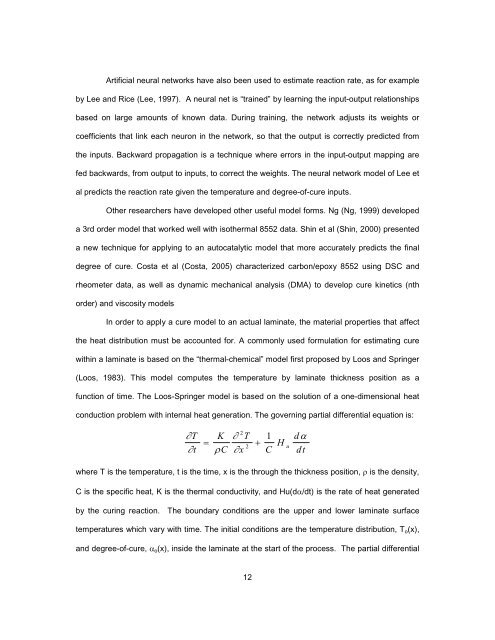TOOLED THICK COMPOSITES by ARVEN H. SAUNDERS III ...
TOOLED THICK COMPOSITES by ARVEN H. SAUNDERS III ...
TOOLED THICK COMPOSITES by ARVEN H. SAUNDERS III ...
Create successful ePaper yourself
Turn your PDF publications into a flip-book with our unique Google optimized e-Paper software.
Artificial neural networks have also been used to estimate reaction rate, as for example<br />
<strong>by</strong> Lee and Rice (Lee, 1997). A neural net is “trained” <strong>by</strong> learning the input-output relationships<br />
based on large amounts of known data. During training, the network adjusts its weights or<br />
coefficients that link each neuron in the network, so that the output is correctly predicted from<br />
the inputs. Backward propagation is a technique where errors in the input-output mapping are<br />
fed backwards, from output to inputs, to correct the weights. The neural network model of Lee et<br />
al predicts the reaction rate given the temperature and degree-of-cure inputs.<br />
Other researchers have developed other useful model forms. Ng (Ng, 1999) developed<br />
a 3rd order model that worked well with isothermal 8552 data. Shin et al (Shin, 2000) presented<br />
a new technique for applying to an autocatalytic model that more accurately predicts the final<br />
degree of cure. Costa et al (Costa, 2005) characterized carbon/epoxy 8552 using DSC and<br />
rheometer data, as well as dynamic mechanical analysis (DMA) to develop cure kinetics (nth<br />
order) and viscosity models<br />
In order to apply a cure model to an actual laminate, the material properties that affect<br />
the heat distribution must be accounted for. A commonly used formulation for estimating cure<br />
within a laminate is based on the “thermal-chemical” model first proposed <strong>by</strong> Loos and Springer<br />
(Loos, 1983). This model computes the temperature <strong>by</strong> laminate thickness position as a<br />
function of time. The Loos-Springer model is based on the solution of a one-dimensional heat<br />
conduction problem with internal heat generation. The governing partial differential equation is:<br />
2<br />
∂T<br />
K ∂ T 1<br />
= 2 +<br />
∂t ρC<br />
∂x<br />
C<br />
12<br />
dα<br />
H u<br />
dt<br />
where T is the temperature, t is the time, x is the through the thickness position, ρ is the density,<br />
C is the specific heat, K is the thermal conductivity, and Hu(dα/dt) is the rate of heat generated<br />
<strong>by</strong> the curing reaction. The boundary conditions are the upper and lower laminate surface<br />
temperatures which vary with time. The initial conditions are the temperature distribution, To(x),<br />
and degree-of-cure, αo(x), inside the laminate at the start of the process. The partial differential
















